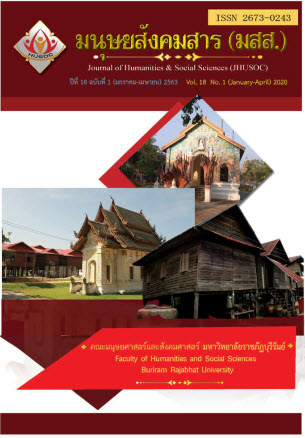Information Graphic Design of Khorat Geopark as the Reflection of Paleogeographical Demonstration
Main Article Content
Abstract
The purpose of this research was to 1) study and analyze the paleogeography of Khorat Geopark area 2) develop suitable information graphic design for the target group to be able to effectively recognize and understand
Khorat Geopark area. The tools that were used were the paleogeography expert interview form and the questionnaire for a sample group. The procedure of research can be divided into 3 phases: 1) analyzing the content 2) finding suitable format for the information graphic design 3) the result of the information graphic design. The result of the research Phase 1: When considering opinions of 5 experts, there was duplicated information in the same direction. It was found that Khorat Geopark occurred in the 6th period of the geologic time. Phase 2: Using mean from the opinion of a sample group of 170 people. The opinions from a sample group on the elements of information graphic design were consistent with the graphic design theory of Alberto Cairo Phase 3: The researchers could arrange content and pictures into the size of 21 X 29.7 cm , for dissemination to the target group to learn and understand it within a short time.
Article Details
เนื้อหาและข้อมูลในบทความที่ลงตีพิมพ์ในวารสารทดสอบระบบ ThaiJo2 ถือเป็นข้อคิดเห็นและความรับผิดชอบของผู้เขียนบทความโดยตรงซึ่งกองบรรณาธิการวารสาร ไม่จำเป็นต้องเห็นด้วย หรือร่วมรับผิดชอบใดๆ
บทความ ข้อมูล เนื้อหา รูปภาพ ฯลฯ ที่ได้รับการตีพิมพ์ในวารสารทดสอบระบบ ThaiJo2 ถือเป็นลิขสิทธิ์ของวารสารทดสอบระบบ ThaiJo2 หากบุคคลหรือหน่วยงานใดต้องการนำทั้งหมดหรือส่วนหนึ่งส่วนใดไปเผยแพร่ต่อหรือเพื่อกระทำการใดๆ จะต้องได้รับอนุญาตเป็นลายลักอักษรจากวารสารทดสอบระบบ ThaiJo2 ก่อนเท่านั้น
References
Cairo, A. (2013). The functional art: An introduction to information graphics and
visualization. San Francisco: New Riders.
Chonglakmani, C. (2010). Sedimentology and paleoenvironment of the petrified-
wood bearing formation in the Khorat Basin. Nakhon Ratchasima:
Suranaree University of technology. [in Thai]
Hall, S. (1997). Representation: Cultural representations and signifying practices.
London: Sage in association with The Open University.
Jintasakul, P. (2018). Khorat Geopark Cuesta & Fossil Land. In UNESCO Global
Geopark & Sustatnable Tourism, 18 - 21 August 2018, Kantary Hotel
Nakhon Rachasima Province, P 1-33. [in Thai]
Krauss, J. (2012). “Infographics: more than words can say.” Learning & leading
with technology, 39(5), 10-14.
Meeusah, N. (2013). Effects of data set and hue on a content understanding of
infographic. Nakhon Nayok: Rajamangala University of Technology
Thanyaburi. [in Thai]
Miller, G. (1956). “The magical number seven, plus or minus two: some limits on
ours capacity for processing information.” Psychological Review. 63(2),
-97.
Payakmarerng, O. School Principal, Thachangratbumroong School. (2019, January
. Interview. [in Thai]
Prachachit, K. (2016). “The design and development of motion infographics for
presenting the legend of Sisaket.” Journal of the Way Human Society,
(1), 116-135. [in Thai]
Saiyot, L. (1996). Techniques for measuring learning results. Bangkok: Children's
Club Publishing. [in Thai]
Siriyuvasak, U. (1999). Social imagination in media lauguages. Bangkok:
Chulalongkorn University. [in Thai]
Yamane, T. (1970). Statistic: An introductory analysis. New York: Harper & Row.
Yamkasikorn, M. (2008). “How to use efficiency criterion in media research and
development: The difference between 90/90 standard and E1/E2.”
E- Journal of Education Studies Burapha University, 19(1), 1-15. [in
Thai]

